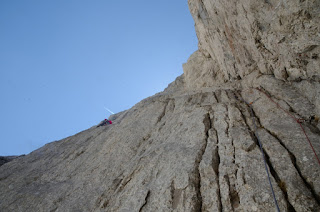Munich is an Alpine city with a mountaineering history. One of the Munich Legends is Hans Dülfer. He went to Munich to study first Medicine, then Jura and later Philosophy. On the 15th of June 1912, Hans Dülfer and Werner Saarschmidt climbed the East face of the Fleischbank. The Fleischbank is a huge limestone cliff that is part of the Wilder Kaiser mountain range, just 60 miles away from Munich. The climb is now graded UIAA VI. In UK terms this means that you should be solid at E1 and you need to be able to climb fast given that the route is 14 pitches. The topo is below. Note the three traverses: the easy left-to-right entry traverse, the right-to-left VI- traverse and another right-to-left V- rated third traverse. In recent years two bolt belays have been created and there are a few crux bolts plus pegs where you need them. We additionally took 14 quickdraws, 4 slings, nuts and cams.
Arno Alpi and I, two Brexit refugees from Scotland (aka the Clova Clova boys), are enjoying our weekly outing to the superb Thalkirchen wall. And they have Pizza & beer, too, so what's not to like! We also did plenty of cycling and wee outings to the Klettergartens (climbing areas) staying nicely within our comfort zone. But we decided that we needed something bigger & badder. So why not try the Dülfer?
Summer came in late May and so I picked Arno up at the S-Bahn station in Unterhaching at 7 am. Within little more than one hour we arrived at the Griesneralm. You do not need to look for long to see climbing opportunities...
There are two paths to reach the high glen between the Fleischbank on the West and the Predigtstuhl on the East. We chose a mini via Ferrata and then continued up snow fields.
Soon we reached the emergency telephone which is located just above the start of the Dülfer. Here another photo of the line. Be sure that the forecast is strong & stable and that your state of mind is strong & stable before starting. If it isn't and if you end up in a thunderstorm then expect the mother of all epics because bailing out is difficult after the second traverse.
There was another team aiming for our route but they were too far left and seemed inexperienced. So we started first. Here is Arno on the easy pitch 2 on the easy initial traverse...
... and here he is belaying me at the end of pitch 2.
Pitch 3 is V+ and is tricky with a backpack. Pitch 4 is graded VI- and involves a polished hold, an overhang, and a long reach. My rucksack was too heavy so I clipped the rucksack into the other rope, just about managed it and then pulled the rucksack up after me. This felt hard for VI- as I have climbed several VIIs at the Thalkirchen climbing wall.
There is a wee bit of grass here and there but the climbing is on solid rock.
Arno then got the up-and-traverse pitch. Here some steep but doable bridging...
... with rests.,,
... and here he is on the traverse. There is an aid rope dangling off a peg. Don't tell anyone but we went for the French free presumably in line with the 1912 ascent.
On the other side of the glen is the Predigtstuhl with at least one team on it.
... and high up in the sky a team on "Vertical Tango", IX. I have never seen a team so way out in space. They seemed almost directly above us.
Here is Arno doing an easier pitch, probably pitch 9, which leads up to the highest traverse.
In case you are unsure whether you are right or not, someone had nicked a "Dülferstrasse" sign in Munich and added it to the traverse.
Here is the Arno at the beginning of the traverse. It is graded V- but practice a bit on the Etive slabs because it is long with a few delicate moves and plenty of exposure. However, again pegs and shiny bolts when you really need them.
Here is Arno trusting the friction of his climbing shoes...
... and here he is going for a more dynamic move.
A little easy climbing and then the two exit pitches that cover the exit chimneys. The second to last is graded VI- and we both did it free. Knee jams helped. The last pitch is very steep, the holds are less than perfect and we both went for the French free. With a rucksack, you need to be solid at E2 to have a chance of freeing it.
Here is Arno bridging just before the trickiest bit.
And whilst it is not really high, you are 2000 m up, so the pumpy moves will make you breathe hard. Here is Arno finishing the route.
Some scrambling to the ridge and then the summit of the Fleischbank.
After that descend on a marked path westwards. There is one bit where you can abseil.
After the descent re-ascent to the bealach, move a wee bit higher to a notch. Aways follow the red signs on the rock and you will reach the abseil piste. Four abseils on good bolts will get you to the floor of the glen. After that 90 min of descent to the Griesneralm.
We had Radlers (Shandy's) at the Griesneralm and at 1 am I was back home.
In total awe that Hans Dülfer and Werner Saarschmidt climbed this in 1912. If you manage to get up the Dülfer then you will agree!
HW






































